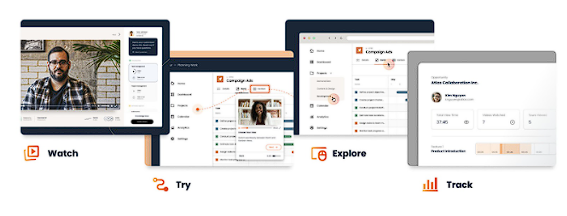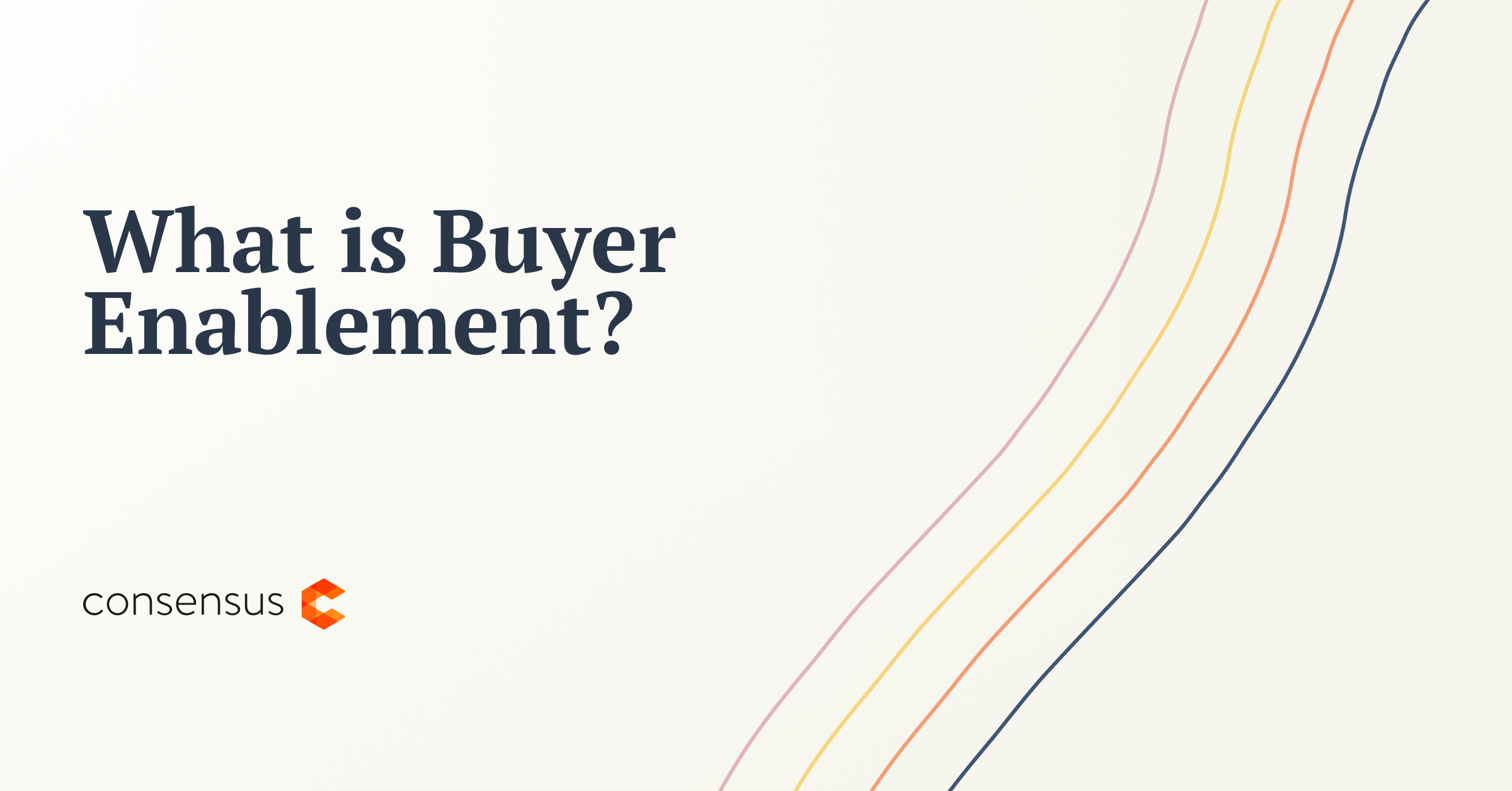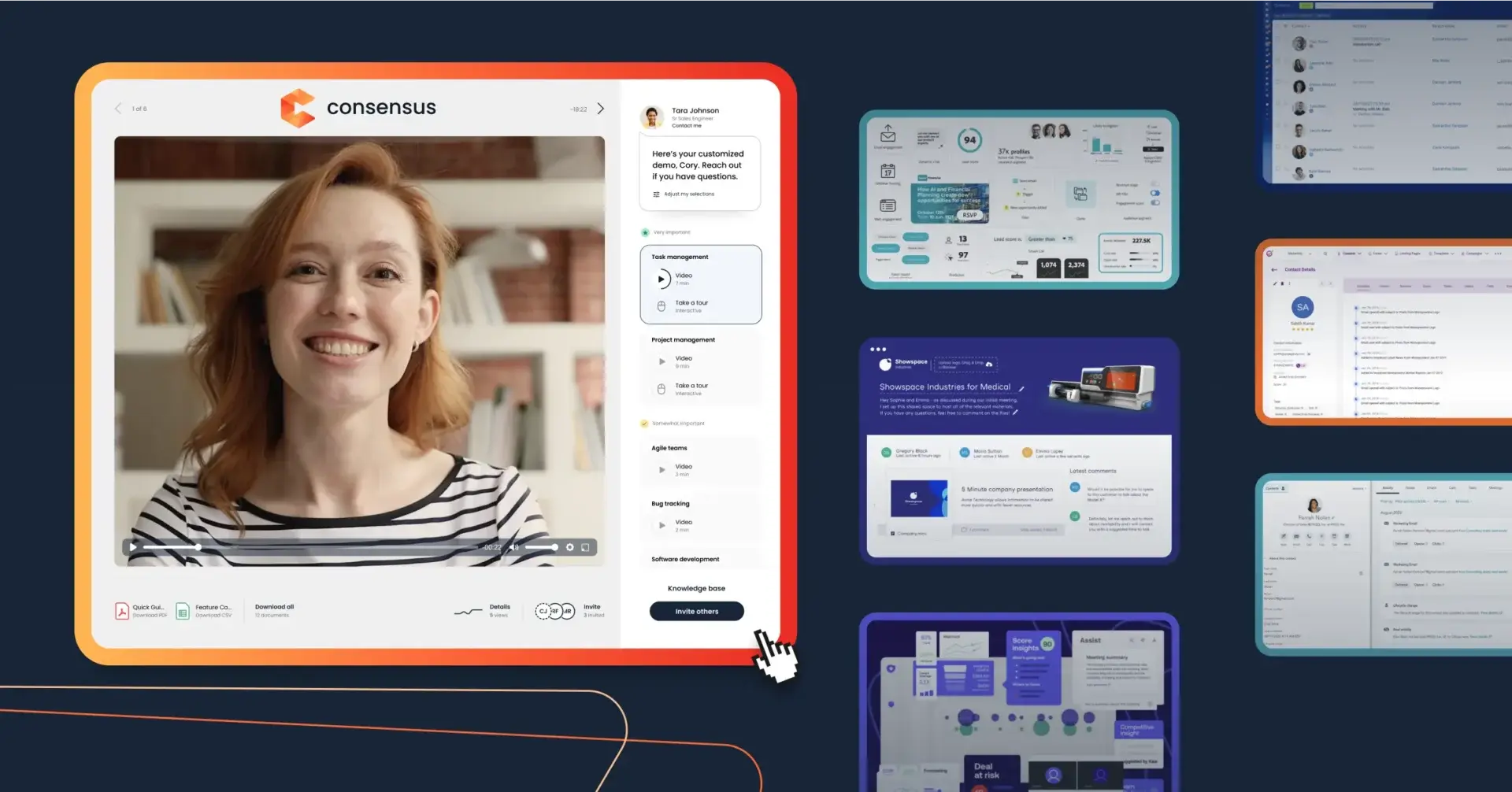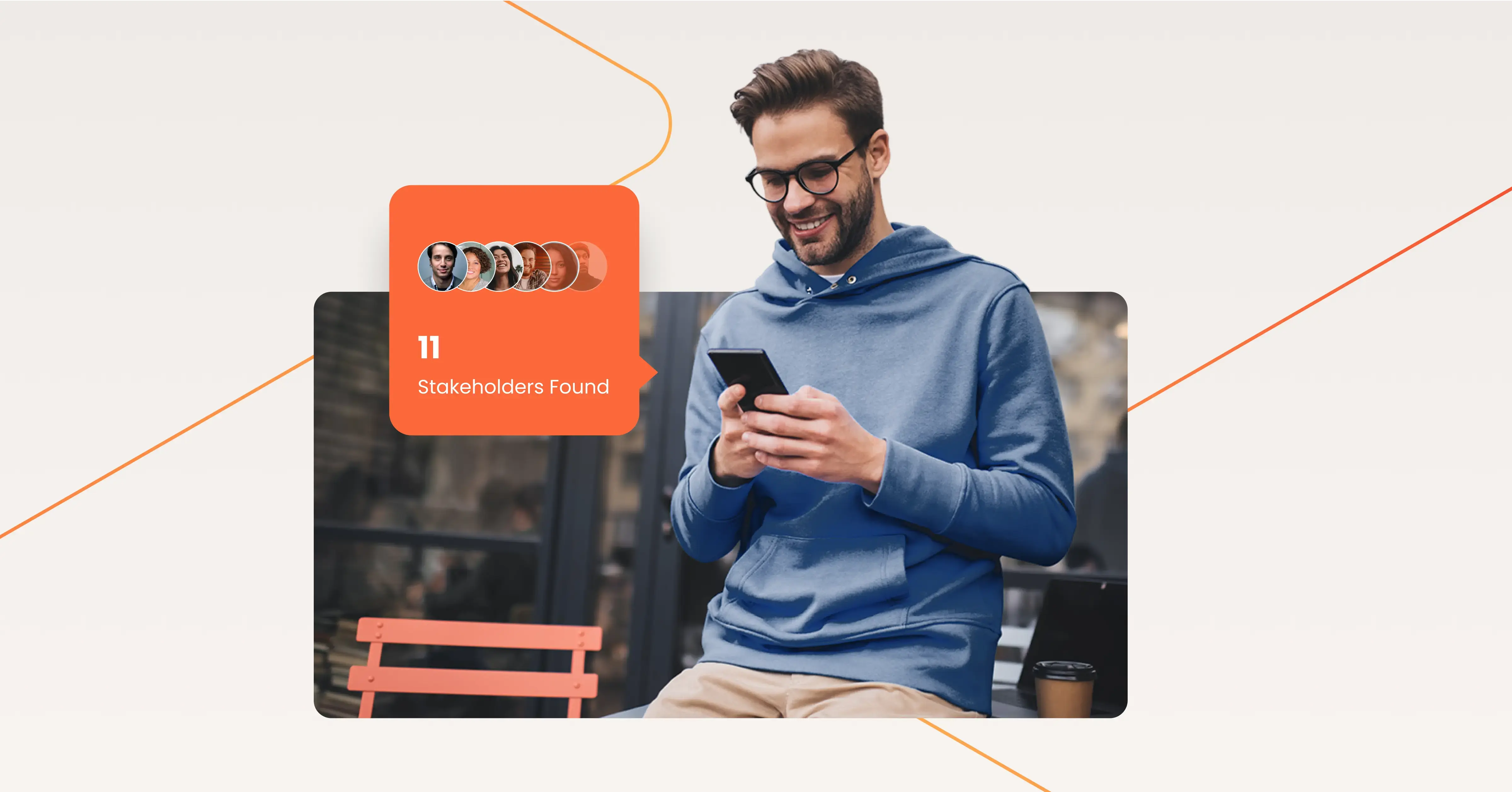With over 20 years of experience, Mark leads Consensus in helping companies expand presales impact ...
Close more deals with
Demo Automation.
Watch a Demo
Modern buyers are more informed and independent than ever. They want to buy on their own terms, exploring solutions at their own pace without relying on sales teams. So, with 83% of the buying process now happening without direct sales involvement, businesses need a better way to meet buyers where they are.
Enter: buyer enablement. It’s the strategy and toolset that empower buyers to self-educate, align stakeholders, and make confident decisions—without waiting for a sales meeting. For sales and presales teams, it’s about providing the right content, context, and tools at the right time—automated, personalized, and ready when the buyer is.
In this article, we’ll explore how buyer enablement works, the tools behind it, and the measurable results it delivers. Let’s make buying easier—for everyone involved.
What is Buyer Enablement?
Buyer enablement is the methodology and mentality of making it as easy as possible for buying groups to buy from you, both during your customer’s first purchase and subsequent renewals and expansions.
Historically, buyers had to rely on sales and presales to move them through “software purchase actions” when they were trying to make positive changes to their business. Now, though, prospects want to be able to move through the sales journey without being dependent on vendors.
Nearly 100% of today’s buyers say they want self-service tools throughout the sales process—which means that today’s sellers need to provide buyers with the resources they need to sell to themselves.
The Benefits of Strong Buyer Enablement
Buyer enablement equips buyers with the tools, resources, and guidance they need to make confident purchasing decisions. By streamlining the buying process, it creates a seamless experience for prospects, reduces friction, and builds trust in the vendor-buyer relationship.
Let’s dive into the difference buyer enablement can make.
Helps Buyers Buy
Gartner reports that 77% of B2B buyers describe their last purchase as difficult or complex. Buyer enablement addresses this complexity by removing roadblocks and building clarity.
When a prospect engages with your team, they generally have a problem they want to solve. Instead of trying to convince or persuade the prospect that you are the best option, you should focus on educating the customer on all their options so they can choose what’s best for their needs.That’s what buyer enablement advocates for—doing what’s best for the customer and giving buyers what they want. A buyer’s experience throughout the sales process has as much impact on completing the deal as the actual solution.
Shortens Sales Cycles
Long sales cycles can drain resources and stall momentum. Buyer enablement addresses this by providing prospects with the resources they need to move forward confidently and quickly.
Today’s buyers expect immediate responses from the companies they want to buy from. It’s now commonly recommended for companies to respond within five minutes of a customer’s inquiry or risk not making the sale.
But research has found that 80% of companies take longer than those five minutes. This delay creates friction, introduces doubt, and slows down buying—especially in complex sales where multiple stakeholders are involved. By empowering buyers to educate themselves and share insights with stakeholders, the entire process speeds up. For example, when buyers can access interactive demos, personalized content, and in-depth product information on their schedule, they don’t have to wait for live meetings or follow-ups. This creates a faster path to consensus across buying groups—ultimately reducing the time it takes to close deals.
Improves Conversion Rates
Buyer enablement is all about equipping prospects with the right information, at the right time, in the right format. It gives decision-makers access to personalized, self-service resources that help them explore the solution, understand the value, and align internally—all on their own terms.
By delivering interactive product overviews, role-specific messaging, and content tailored to unique pain points, buyer enablement helps build trust early and often. It minimizes confusion, reduces back-and-forth, and ensures that every stakeholder—whether technical, economic, or executive—can clearly see how the solution fits their needs.
Empowered buyers are confident buyers—and confident buyers convert at higher rates.
Frees Up Sales and Presales Teams’ Time
Repetitive tasks, such as delivering the same demo multiple times or answering the same questions, can overwhelm sales and presales teams. Buyer enablement helps shift these time-consuming activities to automated, self-service tools.
For example, with demo automation, buyers can explore your product at their convenience, reducing the need for live demos. This gives sales engineers and account executives more time to focus on high-value activities, such as discovery calls, custom configurations, and strategic consultations.
Intent data further optimizes efforts by showing exactly which deals deserve attention. Sales teams can prioritize engaged stakeholders, ensuring that their time is spent where it has the greatest impact. The result is a more efficient team, fewer repetitive tasks, and a better work-life balance for your presales and sales professionals.
Buyer Enablement Tools
Buyer enablement tools bridge the gap between interest and action. They give prospects the ability to engage with your solution in meaningful ways—on their own time, in their preferred format, and aligned to their role. The key is offering tools that meet buyers where they are in their journey, whether they’re exploring the problem, comparing vendors, or building a business case to gain internal buy-in.
1. Product Simulations
Product simulations give buyers the opportunity to experience your solution firsthand. Instead of just hearing about features from a sales rep, they can test them out in a controlled, hands-on environment. This approach is especially effective for technical stakeholders who want to understand how your product fits into their existing systems.
Consensus, the first full-funnel AI-powered demo platform, gives buyers the hands-on experiences they want while empowering presales and sales teams to scale. Using demo automation technology, industry-leading insights, and intelligence buyer and seller enablement tools, Consensus users create interactive, personalized, and engaging demo experiences (at scale) that enable buyers to learn, explore, and evaluate the product in their own time and at their own pace.

2. Interactive Demos
On-demand demos aren’t just a nice-to-have—they increase sales. Buyers want to see the product early, not wait weeks for a live demo. They need to know how it works, what it does, and how it solves their challenges.
When buyers engage with a personalized AI-chosen demo (catered to their needs), they immediately see features that matter most to them. This not only answers their initial questions but also gives them something tangible to share with their teams. It also eliminates long wait times and keeps momentum high.
Plus, interactive demos give sellers insights into what buyers care about, so follow-ups can be more impactful. With Consensus’ Demolytics, sales teams can access AI-enhanced intent data for a precise understanding of buyer priorities. Knowing which features resonate with stakeholders allows sellers to tailor their approach and focus on the most impactful aspects of the product/s. This targeted engagement increases the likelihood of converting opportunities into closed deals.
3. Personalized, Educational Content
Buyers don’t want generic brochures or one-size-fits-all case studies. Four out of five buyers say that they’re more likely to engage with a piece of content if it’s personalized toward their needs.
Think about the technical buyer who needs integration details or the CFO who’s focused on budget impact. Providing helpful, tailored content helps buyers feel understood and valued. It also positions you as a partner who’s invested in their success—not just a vendor pushing a product.
4. ROI Calculators
Buyers need to justify their purchases with numbers and ROI calculators make it easy for them to see the financial benefits of your solution, without waiting on a rep to run the math or build a custom business case.
Instead, buyers can input their current costs, inefficiencies, or resource constraints, and the calculator instantly illustrates how much time, money, or effort your product could save. This not only quantifies the value—it arms buyers with concrete data they can take straight to internal decision-makers.
In a world where purchasing decisions often require buy-in from finance, IT, and multiple lines of business, ROI calculators become powerful tools for building consensus. They move conversations from “why change?” to “why now?”—accelerating urgency and trust in a way that’s both scalable and self-driven.
5. Other Buyer Enablement Tools
Additional tools and resources can strengthen the buyer journey by offering targeted support at every stage, such as:
- Chatbots: Provide instant, conversational support to answer common questions, guide buyers to the right resources, or surface relevant demos—24/7 and without waiting on a sales rep.
- FAQs: Address recurring objections and uncertainties with concise, easy-to-navigate answers. These reinforce credibility and reduce friction during the evaluation process.
- Knowledge bases: Offer deep, searchable content on product functionality, best practices, and troubleshooting. These resources help technically savvy buyers dive deeper without needing live support.
- Integration guides: Provide step-by-step instructions for connecting your product with their current systems.
- Customer success stories: Highlight real-world results achieved by companies like theirs.
- Resource sharing capabilities: Help buyers share demos, whitepapers, or reports with their teams.
- Implementation timelines: Set expectations with a clear roadmap for onboarding and deployment.
By offering the right tools at the right time, you can create a smoother and more efficient buying process. Buyers feel supported, sales teams work smarter, and deals close faster.
Best Practices for Buyer Enablement
Buyers face complex decisions with multiple stakeholders involved, and they expect vendors to make that process as smooth as possible. By offering clarity, self-service options, and tailored resources, you can help buyers move forward with confidence and reduce unnecessary delays.
Here are some best practices for creating a straightforward and supportive experience for buying teams.
Learn the Different Types of Buyers
Not all buyers are the same. Each brings different needs, concerns, and priorities to the table. Here are some of the most common buyer types you’ll want to support:
- The Analytical Buyer: This buyer is detail-oriented and data-driven. They want to see the numbers—ROI, performance metrics, and use cases. To win them over, provide in-depth reports, calculators, and data-backed insights.
- The Relationship Buyer: For this type, trust and personal connection come first. They value vendors who take the time to understand their unique challenges and build long-term partnerships. Building rapport and demonstrating empathy are key to engaging them.
- The Consensus Buyer: Many modern buying groups fall into this category. These buyers represent teams with multiple stakeholders, all of whom need to agree before moving forward. To succeed, you’ll need to equip your internal champion with resources to gain buy-in from the rest of the group.
- The Technical Buyer: These buyers focus on the nuts and bolts—how the product works, how it integrates, and whether it meets specific technical requirements. They want product specs, simulations, and the opportunity to test your solution hands-on.
- The Economic Buyer: Often a CFO or procurement specialist, this buyer is laser-focused on cost-effectiveness and value. They aren’t just looking at the price tag—they want to know if your solution delivers measurable ROI and fits within budget constraints.
Understanding these buyer types helps you tailor your messaging, resources, and approach to create a personalized buying experience that resonates with every type of buyer.
Create a Seamless Product Experience
A seamless product experience isn’t just about showcasing your product—it’s about removing barriers and making the buying process effortless. Buyers want control. They expect to explore solutions on their terms, without delays or excessive back-and-forth.
With Consensus, buyers access a full-funnel interactive demo experience that focuses on four key actions:
- Watch: Engaging, AI-powered demos and video walkthroughs let buyers visualize the product in action, building excitement and clarity.
- Try: Hands-on, interactive product tours and experiences allow buyers to test real use cases, reinforcing the product’s value.
- Explore: Deeper dives into features and capabilities let buyers self-educate and uncover the details that matter most to them.
- Track: Every interaction generates AI-powered insights, helping both buyers and sellers make faster, more informed decisions.

Enable the Buying Group With the DEEP-C Framework
Shifting to a buyer enablement mindset can feel like a big change. Aligning your entire process around helping buyers is even more challenging. That’s where the DEEP-C Framework provides clarity and direction.
This framework focuses on enabling champions to advocate for your solution within their organization. It turns sellers into “Buyer Coaches,” guiding champions through the buying process and helping them win over other stakeholders. Here’s how it works:
- Discover your champion and, through them, identify the other stakeholders. Champions are your biggest allies, but they’re also your best source of information about who else is involved in the decision-making process.
- Engage the champion and, through them, engage each stakeholder. Strong engagement builds trust and allows you to address the unique concerns of everyone involved.
- Equip your champion with everything they need to represent your solution effectively. This includes personalized demos, data, and tools to ensure they feel confident advocating for your product.
- Personalize the value of your solution for each stakeholder. A one-size-fits-all approach doesn’t work in buying groups. Tailor your messaging to address individual priorities, whether it’s technical compatibility, cost savings, or ease of use.
- Coach the champion and stakeholders through the process. Buying decisions are complex, and champions often need guidance to navigate internal dynamics. Act as a coach by providing advice, answering questions, and helping overcome objections.
Our founder, Garin Hess, has explored this approach in depth in his book. The DEEP-C Framework empowers you to align with your buyers, guide them through their challenges, and create meaningful connections that lead to faster, more confident decisions.
Take Charge of Buying; Let Go of Selling
Traditionally, B2B sales strategies and technologies have been focused on making sales more effective for the sales team and individual reps. Buyer enablement, in contrast, focuses on how to make the buying journey and decision-making process easier to navigate for those who actually do the selling: our buyers.
Develop Buyer Empathy
If we were to peel back the layers of ineffectiveness in B2B sales, we’d inevitably see one principle at the root of this problem: sellers are too seller–focused. How do we get customers onto our sales process? What sales training do we need to move deals along? What sales tools will enable us to run our motions better? How are we trending towards our goals?
To start, we have to develop empathy for our buyers. That means stepping into their world and understanding what their day looks like, what internal pressures they face, what keeps them from making progress, and what actually builds confidence.
Most buyers aren’t saying “no”—they’re saying “not yet,” “I’m unsure,” or “I can’t get the rest of the team on board.” And too often, we respond with more pitching, more process, more pressure.
Buyer empathy flips the script. It asks:
- What’s it like to buy this solution inside their org?
- Who needs to be involved, and what do they care about?
- Where are they confused, overwhelmed, or stuck?
- What would we want if we were making this decision ourselves?
When we truly understand these answers, we stop selling at people—and start enabling them.
Overcome Emotional ROI
What we aren’t thinking about nearly often enough is the buyer—what they are thinking and feeling, or what they need to close deals for you. Because that’s at the core of buyer enablement: you can’t close deals, only buyers can.
We unwittingly think that selling is about what we do rather than what the buyer does. And the irony is that selling isn’t about us; it’s about them—we need to understand our buyers more deeply and unpack how they think.
Sell the Pain of Change
Even though buyer enablement is all about making things easier for buyers, selling is part of your job—but you’re selling the pain of change rather than a product. If you don’t sell the customer on the idea that all the headache that comes along with implementation is worth it, you’ll never sell them anything.
No matter what you actually sell, what you provide customers will bring change and disruption to their work lives, at least short term. You have to convince them that any discomfort they’ll feel during training and implementation will not only be worth it, but also beneficial.
Enhance Buyer Enablement with AI-Powered Demo Automation
Buyer enablement isn’t just a strategy—it’s how you give buyers clarity and control in their decision-making process. When buyers feel empowered with the right resources, they’re more likely to move forward confidently, faster, and with fewer roadblocks.
The key is delivering an interactive, buyer-led demo experience that meets buyers where they are. This means giving them access to interactive demos and AI-driven personalized content that help them understand your solution without waiting for scheduled meetings. Buyers don’t want to feel dependent on sales teams—they want to take the reins and explore on their own terms.
With Consensus, you offer your buyers everything they need to sell themselves. Consensus AI feeds the right demo versions to buyers, and those buyers turn into your champions because they have the resources they need to get stakeholders on board. Through automated, interactive demos, your buyers uncover the value of your product at their own pace, no longer waiting for live demos to start their buyer journey.
When you create a buyer-centric experience, you’re not just simplifying the sales process—you’re setting your team apart. If you’re ready to enhance your buyer enablement strategy with AI tools that make the process simpler and more effective, learn how Consensus can help.
Buyer Enablement FAQs
What’s the Difference Between Buyer Enablement and Sales Enablement?
Buyer enablement, on the other hand, focuses entirely on the buyer. It’s about guiding buyers through their journey with resources and tools that help them make decisions confidently, without unnecessary friction. Think of it as flipping the perspective from “How can we sell better?” to “How can we make it easier for buyers to buy?”
For example, sales enablement might involve creating playbooks or hosting sales training sessions. Buyer enablement, however, would provide interactive demos, ROI calculators, and content that speaks directly to buyer concerns. While sales enablement supports the seller, buyer enablement empowers the buyer. Both are critical, but buyer enablement ensures your sales process aligns with how modern buyers want to purchase—which is often on their terms, at their pace.
How Does Buyer Enablement Tie Into the Buyer Journey?
During the awareness stage, buyers are just starting to explore solutions. They need educational content that helps them understand their options and identify potential solutions to their problems. Buyer enablement here might look like offering interactive product tours or sharing relevant case studies.
In the consideration stage, buyers are evaluating vendors and narrowing their choices. At this point, tools like ROI calculators or feature comparisons can help them weigh their options and see how your solution fits their specific needs.
Finally, during the decision stage, buyers are working to align stakeholders and justify their choice internally. This is where buyer enablement tools, like personalized demos or stakeholder sharing capabilities, become critical. They allow champions to present your solution clearly and effectively to the rest of the buying group.
What makes buyer enablement so impactful is that it’s not a one-size-fits-all approach. Instead, it’s a tailored strategy that removes friction and builds confidence throughout the entire journey.
What Is the Difference Between Buyer Engagement and Buyer Enablement?
Buyer enablement goes beyond interaction. It’s about equipping buyers with the tools they need to move forward independently. While engagement is about maintaining interest, enablement is about empowering action.
For instance, imagine a buyer attending a webinar or scheduling a live demo. That’s buyer engagement. Now, imagine giving them access to an on-demand interactive demo after the webinar or sending them a personalized ROI calculation after the demo. That’s buyer enablement.
Both are critical to success, but they serve different purposes. Engagement keeps the relationship alive, while enablement removes barriers and facilitates decisions. Together, they create a seamless experience that builds trust and drives results.
What is Consumer Enablement?
For example, think about online shopping. Tools like product reviews, comparison charts, and virtual try-ons help consumers evaluate options and find the best fit for their needs. These tools empower consumers to take control of their decision-making process without needing extensive interaction with a salesperson.
In B2B, buyer enablement adopts a similar philosophy. Modern buyers expect the same level of convenience and control they experience as consumers. That’s why self-service tools, like interactive demos and knowledge bases, are becoming more common in enterprise sales.
Both consumer enablement and buyer enablement share the same end goal: making the buying process easier, faster, and clearer. Whether you’re helping an individual choose a new pair of headphones or guiding a buying group through a complex software purchase, the principle remains the same—empower the buyer with the right tools and information to make confident decisions.





